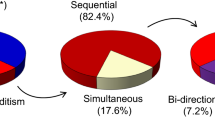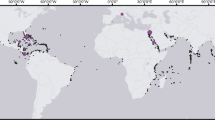Abstract
Life history theory predicts that reproduction and somatic maintenance are negatively related, but the strength of this relationship is expected to depend on food availability. In this study, we investigated asexual reproduction (budding rate) and oxidative stress tolerance as two opposing facets of life history trade-offs in 17 strains of five freshwater hydra species under experimentally simulated low, medium, and high food availability. Stress tolerance was quantified by exposing animals to exogenous H2O2, which mimics reactive oxygen species arising in vivo. The five species differed in life history traits (low budding rate and high stress tolerance in Hydra vulgaris and H. circumcincta and the opposite in H. oligactis and H. viridissima; low budding rate combined with relatively low stress tolerance in H. oxycnida). Stress tolerance and asexual reproduction increased with food, but there were clear interspecific differences in this relationship. Across all strains, stress tolerance and budding rate were significantly negatively related on the low and medium, but not the high food level. These results suggest that resource allocation trade-offs are involved in determining life history traits in hydra; populations/species can be broadly positioned on a fast–slow life history continuum, and response to variation in food varies along this continuum.


Similar content being viewed by others
References
Bates, D., M. Maechler, B. Bolker, & S. Walker, 2014. lme4: Linear mixed-effects models using Eigen and S4. R package version 1.1-7. http://CRAN.R-project.org/package=lme4.
Bielby, J., G. M. Mace, O. R. P. Bininda-Emonds, M. Cardillo, J. L. Gittleman, K. E. Jones, C. D. L. Orme & A. Purvis, 2007. The fast-slow continuum in mammalian life history: an empirical reevaluation. The American Naturalist 169: 748–757.
Blackburn, T. M., 1991. Evidence for a `fast-slow’ continuum of life-history traits among parasitoid Hymenoptera. Functional Ecology 5: 65–74.
Bode, H. R., K. M. Flick & P. M. Bode, 1977. Constraints on the relative sizes of the cell populations in Hydra attenuata. Journal of Cell Science 24: 31–50.
Boggs, C. L., 2009. Understanding insect life histories and senescence through a resource allocation lens. Functional Ecology 23: 27–37.
Bosch, T. C. G. & C. N. David, 1986. Male and female stem cells and sex reversal in Hydra polyps. Proceedings of the National Academy of Sciences 83: 9478–9482.
Bosch, T. C., S. M. Krylow, H. R. Bode & R. E. Steele, 1988. Thermotolerance and synthesis of heat shock proteins: these responses are present in Hydra attenuata but absent in Hydra oligactis. Proceedings of the National Academy of Sciences 85: 7927–7931.
Brennecke, T., K. Gellner & T. C. G. Bosch, 1998. The lack of a stress response in Hydra oligactis is due to reduced hsp70 mRNA stability. European Journal of Biochemistry 255: 703–709.
Bridge, D., A. G. Theofiles, R. L. Holler, E. Marcinkevicius, R. E. Steele & D. E. Martínez, 2010. FoxO and stress responses in the Cnidarian Hydra vulgaris. PLoS One 5: e11686.
Bryden, R. R., 1952. Ecology of Pelmatohydra oligactis in Kirkpatricks Lake. Tennessee Ecological Monographs 22: 45.
Christensen, R. H. B., 2013. Ordinal –Regression models for ordinal data. R package version 2013.9-30. http://www.cran.r-project.org/package=ordinal/.
Clobert, J., T. Garland & R. Barbault, 1998. The evolution of demographic tactics in lizards: a test of some hypotheses concerning life history evolution. Journal of Evolutionary Biology 11: 329–364.
Cook, C. B. & M. O. Kelty, 1982. Glycogen, protein, and lipid content of green, aposymbiotic, and nonsymbiotic hydra during starvation. Journal of Experimental Zoology 222: 1–9.
Finkel, T. & N. J. Holbrook, 2000. Oxidants, oxidative stress and the biology of ageing. Nature 408: 239–247.
Gaillard, J.-M., D. Pontier, D. Allainé, J. D. Lebreton, J. Trouvilliez, J. Clobert & D. Allaine, 1989. An analysis of demographic tactics in birds and mammals. Oikos 56: 59.
Glazier, D. S., 1999. Trade-offs between reproductive and somatic (storage) investments in animals: a comparative test of the Van Noordwijk and De Jong model. Evolutionary Ecology 13: 539–555.
Harshman, L. G. & A. J. Zera, 2007. The cost of reproduction: the devil in the details. Trends in Ecology & Evolution 22: 80–86.
Hecker, B. & L. B. Slobodkin, 1976. Responses of Hydra oligactis to temperature and feeding rate. In Mackie, G. O. (ed), Coelenterate Ecology and Behavior. Springer, New York: 175–183.
Kaliszewicz, A., 2011. Interference of asexual and sexual reproduction in the green hydra. Ecological Research 26: 147–152.
Kaliszewicz, A. & A. Lipińska, 2013. Environmental condition related reproductive strategies and sex ratio in hydras. Acta Zoologica 94: 177–183.
Kelty, M. O. & C. B. Cook, 1976. Survival during starvation of symbiotic, aposymbiotic, and non-symbiotic hydra. In Mackie, G. O. (ed), Coelenterate Ecology and Behavior. Springer, New York: 409–414.
Kessler, E., G. Kauer & M. Rahat, 1991. Excretion of sugars by Chlorella species capable and incapable of symbiosis with Hydra viridis. Botanica Acta 104: 58–63.
King, E. G., D. A. Roff & D. J. Fairbairn, 2011. Trade-off acquisition and allocation in Gryllus firmus: a test of the Y model. Journal of Evolutionary Biology 24: 256–264.
Kirk, K. L., 2001. Dietary restriction and aging –comparative tests of evolutionary hypotheses. The Journals of Gerontology Series A: Biological Sciences and Medical Sciences 56: B123–B129.
Lenhoff, H. M., 1983. Hydra: Research Methods. Plenum Press, New York and London.
Lesser, M. P., 2006. Oxidative stress in marine environments: biochemistry and physiological ecology. Annual Review in Physiology 68: 253–278.
Martínez, D. E., 1998. Mortality patterns suggest lack of senescence in hydra. Experimental Gerontology 33: 217–225.
Martínez, D. E., A. R. Iñiguez, K. M. Percell, J. B. Willner, J. Signorovitch & R. D. Campbell, 2010. Phylogeny and biogeography of Hydra (Cnidaria: Hydridae) using mitochondrial and nuclear DNA sequences. Molecular Phylogenetics and Evolution 57: 403–410.
Muscatine, L., 1965. Symbiosis of hydra and algae—III. Extracellular products of the algae. Comparative Biochemistry and Physiology 16: 77–92.
Muscatine, L. & H. M. Lenhoff, 1965. Symbiosis of hydra and algae. II. effects of limited food and starvation on growth of symbiotic and aposymbiotic hydra. The Biological Bulletin 129: 316–328.
Nakagawa, S., M. Lagisz, K. L. Hector & H. G. Spencer, 2012. Comparative and meta-analytic insights into life extension via dietary restriction. Aging Cell 11: 401–409.
O’Brien, D. M., K.-J. Min, T. Larsen & M. Tatar, 2008. Use of stable isotopes to examine how dietary restriction extends Drosophila lifespan. Current Biology 18: R155–R156.
Partridge, L., M. D. W. Piper & W. Mair, 2005. Dietary restriction in Drosophila. Mechanisms of Ageing and Development 126: 938–950.
Promislow, D. E. L. & P. H. Harvey, 1990. Living fast and dying young: a comparative analysis of life-history variation among mammals. Journal of Zoology 220: 417–437.
Quinn, B., F. Gagné & C. Blaise, 2012. Hydra, a model system for environmental studies. The International Journal of Developmental Biology 56: 613–625.
Reisa, J., 1973. Ecology of hydra. In Burnett, A. (ed), Biology of Hydra. Academic Press, New York and London: 59–105.
Reznick, D., L. Nunney, A. Tessier, D. Reznick, L. Nunney, A. Tessier, D. Reznick, L. Nunney, A. Tessier, D. Reznick, L. Nunney & A. Tessier, 2000. Big houses, big cars, superfleas and the costs of reproduction. Trends in Ecology & Evolution 15: 421–425.
Roff, D. A., 2002. Life History Evolution. Sinauer Associates Inc., Sunderland.
Schaible, R., M. Sussman & B. H. Kramer, 2014. Aging and potential for self-renewal: hydra living in the age of aging –a mini-review. Gerontology 60: 548–556.
Schuchert, P., 2010. The European athecate hydroids and their medusae (Hydrozoa, Cnidaria): Capitata Part 2. Revue suisse de Zoologie 117: 337–555.
Schwentner, M. & T. C. G. Bosch, 2015. Revisiting the age, evolutionary history and species level diversity of the genus Hydra (Cnidaria: Hydrozoa). Molecular Phylogenetics and Evolution 91: 41–55.
Speakman, J. R. & M. Garratt, 2014. Oxidative stress as a cost of reproduction: beyond the simplistic trade-off model. BioEssays 36: 93–106.
Stearns, S. C., 1992. The Evolution of Life Histories. Oxford University Press, Oxford.
Tessier, A. J., M. A. Leibold & J. Tsao, 2000. A fundamental trade-off in resource exploitation by Daphnia and consequences to plankton communities. Ecology 81: 826–841.
Tökölyi, J., M. E. Rosa, F. Bradács & Z. Barta, 2014. Life history trade-offs and stress tolerance in green hydra (Hydra viridissima Pallas 1766): the importance of nutritional status and perceived population density. Ecological Research 29: 867–876.
Tomczyk, S., K. Fischer, S. Austad & B. Galliot, 2015. Hydra, a powerful model for aging studies. Invertebrate Reproduction & Development 59: 11–16.
Turrens, J. F., 2003. Mitochondrial formation of reactive oxygen species. The Journal of Physiology 552: 335–344.
van Noordwijk, A. J. & G. de Jong, 1986. Acquisition and allocation of resources: their influence on variation in life history tactics. The American Naturalist 128: 137–142.
Yoshida, K., T. Fujisawa, J. S. Hwang, K. Ikeo & T. Gojobori, 2006. Degeneration after sexual differentiation in hydra and its relevance to the evolution of aging. Gene 385: 64–70.
Zera, A. J. & L. G. Harshman, 2001. The physiology of life history trade-offs in animals. Annual Review of Ecology and Systematics 32: 95–126.
Acknowledgments
We thank the Associate Editor, Diego Fontaneto, and two anonymous reviewers for their helpful comments on the manuscript. Financial support was provided by the SROP-4.2.2.B-15/1/KONV-2015-0001 project. The project has been supported by the European Union, co-financed by the European Social Fund.
Author information
Authors and Affiliations
Corresponding author
Additional information
Handling editor: Diego Fontaneto
Electronic supplementary material
Below is the link to the electronic supplementary material.
Rights and permissions
About this article
Cite this article
Tökölyi, J., Bradács, F., Hóka, N. et al. Effects of food availability on asexual reproduction and stress tolerance along the fast–slow life history continuum in freshwater hydra (Cnidaria: Hydrozoa). Hydrobiologia 766, 121–133 (2016). https://doi.org/10.1007/s10750-015-2449-0
Received:
Revised:
Accepted:
Published:
Issue Date:
DOI: https://doi.org/10.1007/s10750-015-2449-0




